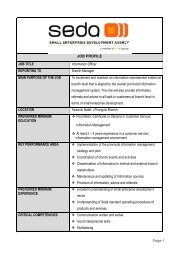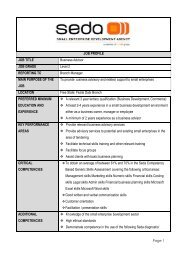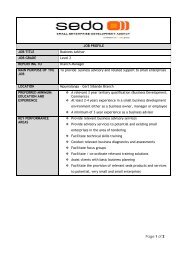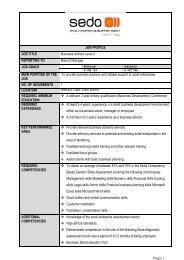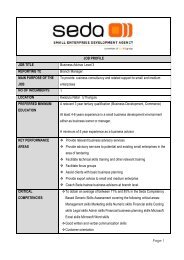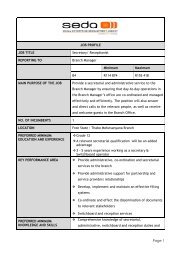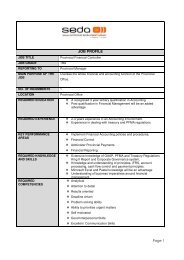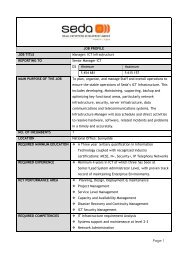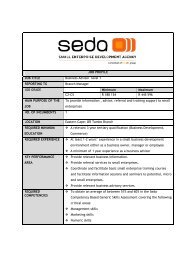Assessment of Cooperatives in the Poultry Industry - 2013.pdf - Seda
Assessment of Cooperatives in the Poultry Industry - 2013.pdf - Seda
Assessment of Cooperatives in the Poultry Industry - 2013.pdf - Seda
Create successful ePaper yourself
Turn your PDF publications into a flip-book with our unique Google optimized e-Paper software.
Research Report: Address<strong>in</strong>g <strong>the</strong> Needs, Opportunities and Challenges <strong>of</strong> <strong>Cooperatives</strong><br />
and Collectively Owned Enterprises <strong>in</strong> <strong>the</strong> <strong>Poultry</strong> and Related Industries<br />
develop and adopt a structured support model that will ensure an <strong>in</strong>tegrated approach<br />
towards support<strong>in</strong>g cooperatives. Figure 5-1 below illustrates a high level view <strong>of</strong> <strong>the</strong><br />
proposed support model.<br />
Figure 5-1: Proposed Support Model<br />
Cooperative approaches<br />
SEDA for assistance<br />
Cooperative choses<br />
which form <strong>of</strong> tra<strong>in</strong><strong>in</strong>g<br />
or equipment to receive,<br />
based on plan<br />
Cooperative monitored<br />
as <strong>the</strong>y cont<strong>in</strong>ue to do<br />
bus<strong>in</strong>ess<br />
Feasibility <strong>of</strong><br />
cooperative is assessed<br />
Milestones for<br />
development and<br />
monitor<strong>in</strong>g are def<strong>in</strong>ed<br />
with cooperative<br />
<strong>Assessment</strong> <strong>of</strong><br />
cooperative's use <strong>of</strong><br />
tra<strong>in</strong><strong>in</strong>g/ resources <strong>in</strong><br />
l<strong>in</strong>e with conditions for<br />
development<br />
Mentor assigned to<br />
cooperative based on<br />
database <strong>of</strong> approved<br />
providers<br />
Tra<strong>in</strong><strong>in</strong>g and<br />
development plan<br />
formulated with<br />
cooperative<br />
If resource use has met conditions,<br />
cont<strong>in</strong>ue to next item on tra<strong>in</strong><strong>in</strong>g<br />
and development plan<br />
If resource use has been poor,<br />
pause relationship until recipient<br />
meets requirements set out<br />
With<strong>in</strong> <strong>the</strong> framework <strong>of</strong> this model, it is necessary that cooperative support be provided on<br />
an <strong>in</strong>dividual basis, based on <strong>the</strong> needs <strong>of</strong> <strong>in</strong>dividual cooperatives. This approach should<br />
<strong>in</strong>clude an <strong>in</strong> depth assessment <strong>of</strong> <strong>the</strong> bus<strong>in</strong>ess and its members <strong>in</strong> order to ga<strong>in</strong> clarity on<br />
<strong>the</strong>ir skills, resources and motivations. Based on this <strong>in</strong>formation, <strong>in</strong>dividualised<br />
development paths should be formulated for each cooperative. A support guidance manual<br />
sett<strong>in</strong>g out <strong>the</strong> best practice development path <strong>of</strong> a bus<strong>in</strong>ess should be created, based on<br />
which tailored development plans could be compiled for each cooperative. The<br />
establishment <strong>of</strong> customised <strong>in</strong>dividual tra<strong>in</strong><strong>in</strong>g and development plans for cooperatives<br />
through this method would improve agency and ensure that <strong>the</strong> tra<strong>in</strong><strong>in</strong>g that cooperatives<br />
receive is <strong>in</strong> l<strong>in</strong>e with <strong>the</strong>ir specific needs and capacities. A greater sense <strong>of</strong> agency by<br />
cooperative members for <strong>the</strong>ir bus<strong>in</strong>ess plans and goals creates greater autonomy and will<br />
work towards decreas<strong>in</strong>g <strong>the</strong> dependency <strong>of</strong> cooperatives.<br />
As is highlighted <strong>in</strong> <strong>the</strong> case study below (refer section 5.1.2), conditionalities placed on<br />
support improve <strong>the</strong> success rate <strong>of</strong> <strong>in</strong>terventions. The last three steps <strong>in</strong> <strong>the</strong> process<br />
diagram above illustrate how this would function <strong>in</strong> <strong>the</strong> recommended support approach.<br />
<strong>Cooperatives</strong> should be made aware <strong>of</strong> <strong>the</strong> expectations from <strong>the</strong> outset and <strong>in</strong>volved <strong>in</strong> <strong>the</strong><br />
sett<strong>in</strong>g <strong>of</strong> expectations for <strong>the</strong>ir bus<strong>in</strong>ess progress. It is <strong>the</strong>n possible to evaluate<br />
cooperatives based on criteria that <strong>the</strong>y have <strong>the</strong>mselves set out. If <strong>the</strong>y do not comply with<br />
<strong>the</strong> standards set out for assistance, <strong>the</strong> support should be halted until cooperatives are able<br />
to prove that <strong>the</strong>y are mak<strong>in</strong>g use <strong>of</strong> <strong>the</strong> tra<strong>in</strong><strong>in</strong>g and support provided. This will prevent<br />
dependency, as cooperatives have to prove that <strong>the</strong>y are capable <strong>of</strong> grow<strong>in</strong>g on <strong>the</strong>ir own<br />
from a base <strong>of</strong> support, before <strong>the</strong>y are eligible to receive any fur<strong>the</strong>r assistance.<br />
81 | P a g e U r b a n - E c o n : D e v e l o p m e n t E c o n o m i s t s



